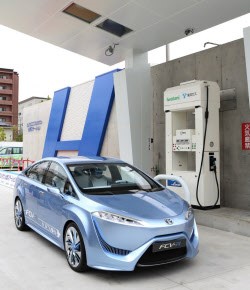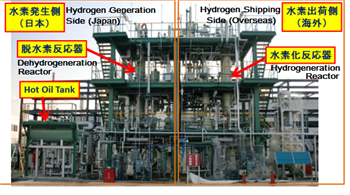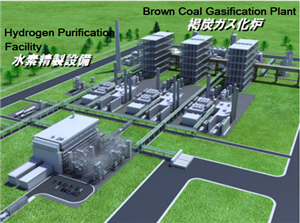Science & Technology: Energy (Hydrogen Business) Japanese-English Translation Sample
Source: Nikkei Newspaper Online Article of Nov 13 2013
Original Text
For the items highlighted in yellow, please refer to the Comments From The Translator below.
CO2出さない水素製造事業、巨大市場見据え世界で始動
2013/11/13 7:00
燃焼しても二酸化炭素(CO2)を排出しない水素をエネルギー源として大規模に活用する、「水素社会」の実現を目指すプロジェクトが世界各地でスタートしている(図1)。水素インフラ関連の市場規模は、2050年には年間160兆円に上ると見られる(日経BPクリーンテック研究所調べ)。そうした水素社会を実現するために不可欠な取り組みとして注目されているのが、CO2の排出を伴わない(CO2フリー)水素製造プロジェクトである。背景には、先進国が「2050年までに先進国全体のCO2排出量を80%削減する」という、2009年のG8ラクイアサミットにおける合意がある。水素インフラの関係者はこの合意を基に水素社会の将来像を描いており、そのためにはCO2フリーの水素を作ることが前提条件になっている。

図1 水素社会を目指すプロジェクト。写真は、とよたエコフルタウン水素ステーションとトヨタ自動車の燃料電池車
水素は自然界にはほとんど存在せず、炭化水素や水などの形で化合物として存在している。このため、何らかの方法でこれらの化合物にエネルギーを加えて水素を製造する必要がある。現状では、工場で産出される副生水素でまかなっており、足りない場合には化石燃料を改質して製造している。これらの水素製造プロセスではエネルギーを加える過程でCO2を排出してしまう。
これに対して、(1)再生可能エネルギーの電力によって水を電気分解する、(2)化石燃料を改質またはガス化するものの、「CCS(Carbon dioxide Capture and Storage)」(改質やガス化時などで発生するCO2を、大気に放出する前に分離・回収して貯蔵すること)というプロセスを経ることによってCO2フリー化する――という二つの方向でCO2フリーの水素を製造する試みが活発化している。
■世界で動く28のプロジェクト
日経BPクリーンテック研究所が世界の主要な水素インフラ関連プロジェクトを調べたレポート『世界水素インフラプロジェクト総覧』(2013年10月24日発行)によると、主要なプロジェクト70の内、CO2フリーを目指した水素製造プロジェクト数は28にのぼった。
このうち、再生可能エネルギーを使ったCO2フリー化のプロジェクトは26に及んだ。それをタイプ別にみると風力発電から製造するプロジェクトが最も多く10、再生可能エネルギー全般から水を電気分解して水素を製造するプロジェクトが6、バイオガスから製造するプロジェクトが6、太陽光発電から製造するプロジェクトは3となった。
水力発電から水素を製造するプロジェクトは1つだけだが、これはすでに一部で普及していることから電力需給に使う先進的な取り組みだけをピックアップしたためである。一方、炭田や天然ガス田の産地でガス化や改質に併せてCCSを行うことによってCO2フリー化するプロジェクトは、2を数えた。
■ドイツで活発な風力発電からの水素活用
その中でも目立つのは、ドイツにおける風力発電の電力から電気分解で水素を製造するプロジェクトである。ドイツは脱原発に踏み切っていることから、再生可能エネルギーの中でも風力発電の導入を活発化させており、その多くが北ドイツに集中している。
北ドイツには大きな電力需要がないために、工業地帯である南ドイツへ送電する必要があるが、高圧送電線の敷設が遅れている。そこで、北ドイツの風力発電で余った電力から水素を製造して活用するプロジェクトが増えているのである。
例えば、ドイツの首都ベルリンから北に120km離れたブランデンブルク州プレンツラウで進められている「プレンツラウ風力水素プロジェクト」では、合計6MWの風力発電で発電した電力を通常は系統網に送っている。しかし、夜など電力需要が小さく、電力が余剰になる場合には、水を電気分解して水素を製造してタンクに貯めておく。
貯蔵した水素は、必要に応じてバイオマスから製造したメタンなどの可燃性ガス(バイオガス)と混ぜて、コージェネレーション(熱電併給)システムに供給する。コージェネ設備では電気は電力系統網に流し、排熱は地域熱供給に販売する。水素の一部は、ベルリン市内などにある燃料電池車(FCV)と水素自動車向けの水素ステーションにも供給する、といった取り組みをスタートさせている。
水素を都市ガスのメタンに混合して燃料として使うハイタン(Hythane:水素混合都市ガス)のプロジェクトでも、風力発電からの水素を活用するプロジェクトが増えている。代表例は、ドイツの「パワー・ツー・ガス」である。E.ONやGreenpeace Energyといったエネルギー会社が風力発電の余剰電力を使って水を電気分解で水素に転換して、既存のガス配管網に供給している。
こうして余剰電力を有効活用すると共に、クリーンな水素を添加することでSOX(硫黄酸化物)やNOX(窒素酸化物)などの有害物質の排出を削減できる。既存の都市ガスインフラを活用できることから、水素社会へ移行するきっかけになるとみられる。
■CO2フリー水素からメタンを製造
水素の形で都市ガスに混ぜるのではなく、都市ガスの成分であるメタンそのものを水素から製造しようという動きも活発化している。ドイツでは、Solar Fuelが再生可能エネルギーによる電力で水を電気分解して水素を作り、それをさらに空気中のCO2と反応させてメタンを製造するプラントを造って実証実験を進めている。
図2 アウディの「eガス」プラント
2009年には再生可能エネルギーの出力が25kWの試作機を稼働し、40%の効率でメタンを製造することに成功した。2013年にはそれを20MWにスケールアップし、本格実用化を目指している。同社の場合、製造したメタンをそのまま天然ガスのパイプライン(ガスグリッド)に供給することを狙っている。都市ガスインフラを活用でき、都市ガスをCO2フリーにできるメリットがある。
再生可能エネルギー由来の水素とCO2から作ったメタンを自動車に活用しようという試みも始まっている。自動車メーカーのAudi(アウディ)が進める「アウディ e-gasプロジェクト」だ。このプロジェクトでは、6MWの電力で水を電気分解して水素を生成し、その水素とCO2で年間1000tのメタンガス製造能力を持つ設備を、2013年秋から本格稼働させる(図2)。同社が販売しているCNG(圧縮天然ガス)車の燃料にしたり、公共ガスネットワークにも供給する計画だ。
■太陽光発電からの水素を地域やビルに活用
太陽光発電の電力を使って水素を製造する試みも次第に増えてきている。有名なものとしては、フランス・コルシカ島の「MYRETプラットフォームプロジェクト」がある。太陽光発電システムの余剰電力で水を電気分解して水素を製造し、電力需要のピーク時や太陽光発電電力の平準化のために燃料電池で発電し、コルシカ島の系統網に送電する実験を進めている。
太陽光の場合には、ビルや住宅といった需要家の施設にも導入されていることから、施設内で太陽光の電力を水素に変えて活用するプロジェクトもスタートした。例えば、オーストラリアのグリフィス大学では、ビルの屋根に太陽光パネルを設置して、日中、太陽光が照っている時間にはその電力を施設内で直接使い、余剰電力は蓄電池に貯めると共に、電気分解による水素製造に利用する。生成された水素は、水素吸蔵合金に貯める。
蓄電池に貯めた電力は主に夜間にエアコン駆動などに使い、水素は曇天や雨天時に燃料電池を介して電力を供給するといった運用をしている。水素だけで同施設の1日分の電力を賄えるとしている。
■化石燃料からCCSでCO2フリー水素化
化石燃料から水素を製造する手法については、天然ガス田や炭田を持つ現地でCCSによって、CO2フリーにする検討が進んでいる。長期的には貯留したCO2を炭素資源とする基礎研究も始まっている。同方法については千代田化工建設や川崎重工業など日本勢がリードしている。
千代田化工建設は、トルエンを水素化したメチルシクロヘキサン(MCH)によって、海外の天然ガス田などで製造した水素を輸送する方法を開発している(図3)。MCHは常温・常圧の液体で、気体水素の体積を500分の1にできる。水素を取り出すプロセスでエネルギーがかかるが、ケミカルタンカーやタンクローリーなど既存の輸送インフラを活用できるメリットがある。
図3 メチルシクロヘキサンの実証プラント。2013年3月に横浜市にある研究開発拠点に毎時5 0Nm3規模の実証プラントを建設(出展:千代田化工建設)
一方、川崎重工業は、オーストラリアの炭田で産出される褐炭を原料に、CCSを併用してCO2フリーの液体水素を現地で製造し、それを船で日本に輸送するビジネスを推進している(図4)。液体水素を選んだのは、不純物を除去するなどの手間がかからず、輸送して直ちに使える点を評価したからだという。液体水素輸送船については、LNG船よりも低温に冷却するなど新規に開発する必要があるが、川崎重工は仕様を詰めており、事業化が可能と見ている。
図4 2030年に本格稼働を目指す商用チェーンのFS(事業化調査)による、水素製造装置のイメージ(出展:川崎重工業)
千代田化工建設は水素輸送ビジネスを2015年度末から、川崎重工業は商用チェーンの本格稼働を2030年からスタートさせるとしている。両者ともに、稼働時の水素の輸入価格を約30円/Nm3(ノルマル・リューベ)としており、安価なCO2フリー水素を大量に供給する考えだ。これらが軌道に乗れば日本が世界の水素ビジネスをリードできる可能性を秘めている。
(日経BPクリーンテック研究所 藤堂安人)
Translation
CO2-free Hydrogen production businesses, getting started in the world targeting a huge market
Nov 13, 2013 7:00
Projects aimed at the realization of "hydrogen society", in which hydrogen that does not emit carbon dioxide (CO2) when burnt serves as an energy source in a large scale, have been started in the world. (Figure 1) The market size of hydrogen infrastructure-related industries is expected to reach 160 trillion yen in 2050 (according to a survey conducted by Nikkei BP CleanTech Institute). The approaches that are attracting attention as essential ones for achieving such hydrogen society are projects for hydrogen production without causing CO2 emissions (CO2-free hydrogen production). The background to this is the pledge to "reduce the amount of CO2 emissions of the entire developed nations by 80% by 2050", an agreement made among the G8 nations at the 2009 L'Aquila Summit. People involved in the hydrogen infrastructure have images of the future of the hydrogen society in their mind based on this agreement, and for achieving this, generating CO2-free hydrogen is required as a precondition.
Figure 1: A project aimed at hydrogen society. The photograph shows a hydrogen station of Toyota Ecoful Town and Toyota Motor Corporation's fuel cell vehicle.
Hydrogen rarely exists in nature, and it usually exists as a form of a compound such as hydrocarbons and water. Therefore, energy needs to be added to these compounds in some sort of way to produce hydrogen. Currently, by-product hydrogen produced in factories covers the demand, and in case of a shortage, hydrogen is produced by reforming fossil fuels. In these methods for producing hydrogen, CO2 needs to be emitted in processes of adding energy.
As approaches for addressing this, attempts to produce CO2-free hydrogen are becoming active in two directions; 1) water electrolysis using electricity from renewable energy sources and 2) achieving CO2-free reformation or gasification of fossil fuels by having a process of "CCS (Carbon dioxide Capture and Storage)" (separate, capture, and store CO2 generated during processes such as reformation and gasification before emission into the air).
*28 projects that are on-going in the world
According to "A Comprehensive List of the World's Hydrogen Infrastructure Projects" (published on Oct. 24th, 2013), a report that lists the results of a survey conducted by Nikkei BP CleanTech Institute on the world's major hydrogen infrastructure-related projects, among 70 major projects, the number of the projects aimed at CO2-free hydrogen production reached 28.
Among them, the number of the projects to implement CO2-free hydrogen production using renewable energy reached 26. They can be classified as below; projects on hydrogen production from wind power generation accounted for the largest number of 10, the number of projects on the production of hydrogen by electrolyzing water using renewable energy in general was 6, 6 projects also on the production from biogas were counted, and 3 on the production from solar photovoltaic power generation.
Only one project to produce hydrogen from water power generation is listed, but this is because these kinds of projects have already been spread in some fields, and only a progressive one for using it for electrical supply and demand was picked-up. In addition to them, 2 projects to achieve CO2-free production by implementing CCS in combination with gasification and reformation in regions where coalfields and natural gas fields are located were counted.
*Hydrogen utilization from wind power generation that is lively in Germany
A noticeable one among them is a project for producing hydrogen by electrolysis using wind power generated electricity in Germany. Germany is especially promoting the introduction of wind power generation, even among renewable energy sources as it has already taken steps toward nuclear-free power generation, and many of the wind power plants are concentrated in Northern Germany.
As there is no large demand for electricity in Northern Germany, the electricity needs to be transmitted to the industrial zone, Southern Germany, but the construction of high-voltage power transmission lines has been delayed. Therefore, projects to produce hydrogen from the surplus electricity generated by wind power in Northern Germany, and utilize it have been increasing.
For example, in the "Prenzlau wind power-to hydrogen project" that is on-going in Prenzlau in Brandenburg located in the north at a distance of 120 km from Berlin, the capital city of Germany, usually, 6 MW of wind-generated electricity in total is sent to a power system network. However, in case extra electricity is generated because of a smaller demand for electricity during off-peak times such as nights, water is electrolyzed for producing hydrogen, and stored in a tank.
The stored hydrogen is mixed with combustible biomass-produced gases (biogas) such as methane, and supplied to a cogeneration (combined heat and power) system, as necessary. In the cogeneration equipment, the electricity is sent into an electric power system network, and the exhaust heat is sold to local heating suppliers. Activities such as supplying a part of hydrogen to the facilities in locations like inside the city of Berlin, such as hydrogen stations for fuel cell vehicles (FCV) and hydrogen cars, have been initiated.
Also among "Hythane" (hydrogen-blended town gas) projects to use hydrogen as a fuel by blending it into methane of town gas, projects to utilize hydrogen from wind power generation have been increasing. As a typical example, there is German "Power to Gas". Energy companies such as E.ON and Greenpeace Energy transform water into hydrogen with electrolysis using surplus electricity generated by wind power, and supply it to the existing gas grids.
These methods provide not only effective use of the surplus electricity but also decreases in emissions of harmful substances such as SOX (sulfur oxide) and NOX (nitrogen oxide) by adding clean hydrogen. As the existing town gas infrastructure can be utilized in these methods, the activities have been considered to trigger the transition to the hydrogen society.
*Produce methane from CO2-free hydrogen
Instead of blending hydrogen into town gas as a form of itself, efforts to produce methane itself, a constituent of town gas, from hydrogen are also becoming active. In Germany, Solar Fuel created a plant to produce hydrogen with water electrolysis using electricity from renewable energy sources and produce methane by the reaction of the produced hydrogen with CO2 in the air, and is working on demonstration experiments to achieve this.
Figure 2: Audi’s "e-gas" plant
In 2009, this company operated a prototype with renewable energy output of 25 kw, and succeeded in producing methane at 40% of efficiency. In 2013, they scaled up the prototype to 20 MW, and are aiming to put it into full-scale practical use. In case of this company, the target is to supply the produced methane to the natural gas pipeline (gas grid) as it is. There are the advantages that the town gas infrastructure can be utilized, and that town gas can be CO2-free in this project.
An attempt to utilize the renewable energy-derived hydrogen and the methane produced with CO2 in automobiles has also been initiated. It's "Audi e-gas project" carried out by an automobile manufacturer, Audi. In this project, a facility that has a capacity to generate hydrogen with water electrolysis using 6 MW of electricity, and produce 1,000 tons of methane gas per year from the generated hydrogen and CO2, will be put into full-scale operation in the fall of 2013. (Figure 2) They have plans to use the produced methane gas as fuels of the CNG (compressed natural gas) cars they sell and supply it to public gas networks.
*Utilize hydrogen from solar photovoltaic power generation in local areas and buildings
Efforts to generate hydrogen using solar photovoltaic-generated electricity are also increasing gradually. One of the famous projects is "MYRET platform project" in Corsica in France. In this project, experiments to produce hydrogen by electrolyzing water using surplus electricity from a solar photovoltaic power generation system, generate electricity with fuel-cells for using during time of peak demand and for leveling the solar photovoltaic-generated electricity, and transmit the electricity to a power system network in Corsica are in progress.
In case of solar photovoltaic power generation, as it has been introduced also in customers' facilities such as buildings and housing, projects to convert the solar photovoltaic-generated electricity into hydrogen in these facilities and utilize it have also been initiated. For example, at Griffith University in Australia, solar photovoltaic panels have been mounted on the roof. During the daytime, the electricity is used directly in the facility while sunlight is available, and the surplus electricity is stored in a storage battery for use in electrolysis for hydrogen production. The generated hydrogen is stored in metallic alloys for hydrogen storage.
This is working in a system where the electricity stored in the storage battery is used mainly for driving air conditioners at nighttime, and the hydrogen supplies electricity through fuel-cells on cloudy or rainy days. They say that hydrogen alone can cover one day's worth of electricity for the facility.
*CO2-free hydrogenation by CCS from fossil fuels
As to the methods to produce hydrogen from fossil fuels, studies, on CO2-free methods achieved by local CCS in the regions where natural gas fields and coalfields are located, are in progress. In the long term, basic researches on using stored CO2 as a carbon resource have also been started. In the field of this method, Japanese companies such as Chiyoda Corporation and Kawasaki Heavy Industries are leading.
Chiyoda Corporation is developing a method to transport hydrogen produced in places such as overseas natural gas fields by using methylcyclohexane (MCH) created by hydrogenation of toluene. (Figure 3) MCH is a room-temperature and normal-pressure liquid that can reduce the volume of gaseous hydrogen into 1/500. Even though energy is required in the process of extracting hydrogen, this method has the advantage that the existing infrastructure such as chemical tankers and tank trucks can be utilized.
Figure 3: The demonstration plant for methylcyclohexane.
Constructed a 50 Nm3/h demonstration plant in a R&D center located in Yokohama in March, 2013. (Exhibitor: Chiyoda Corporation)
On another side, Kawasaki Heavy Industries is pushing ahead with a business to use brown coal that is mined in coalfields in Australia as materials to locally produce CO2-free liquid hydrogen in combination with CCS and transport it to Japan by ship. (Figure 4) They say that liquid hydrogen was chosen because of its advantages that it does not require the processes such as the removal of impurities, and that it will be available for use immediately after the transportation. A new carrier for transporting liquid hydrogen needs to be developed because of a new specification such as cooling at lower temperatures than LNG carriers, but Kawasaki Heavy has already worked out the specifications, and considers that the industrialization is possible.
Figure 4: An image of hydrogen production equipment by a FS (feasibility study) on a commercial chain with its full-capacity operation targeted for 2030. (Exhibitor: Kawasaki Heavy Industries)
Chiyoda Corporation states that it will start its hydrogen transportation business at the end of 2015, and Kawasaki Heavy Industries says that the commercial chain will commence operating at full capacity in 2030. Both companies state that they will set the hydrogen export price at around 30 Yen per Nm3 (normal cubic meter) at the beginning of the operation, and have ideas of providing low-cost CO2-free hydrogen in large quantities. Getting these projects on track will bring the potential for Japan to lead the world's hydrogen businesses.
(Yasuto Todo, Nikkei BP CleanTech Institute)
Comments From The Translator
| 原文 | 訳文 | 連絡事項 |
|---|---|---|
| 先進国全体の | the entire developed nations | 実際にはG8加盟国のことだと思いますが、原文通りにしておきました。 |
| 再生可能エネルギーの電力によって | using electricity from renewable energy sources | 再生可能エネルギー源から得られる電力を使用して、という意味であると判断し、エネルギー源(energy sources)という意味になるように、sourcesを追加しました。 |
| 再生可能エネルギーによる電力で | using electricity from renewable energy sources | 上記と同様の理由により、sourcesを追加しました。 |
| 再生可能エネルギーの中でも風力発電の導入を | the introduction of wind power generation, even among renewable energy sources | 再生可能エネルギー源の中でも風力発電の導入を、という意味であると判断し、上記同様sourcesを追加しました。 |
| 風力発電から製造するプロジェクト | projects on hydrogen production from wind power generation | 原文では、製造対象の「水素」が省略されていると判断し、わかりやすくなるように、「風力発電からの水素製造のプロジェクト」という意味の訳にしました。 |
| バイオガスから製造するプロジェクト | the production from biogas | 上記同様、製造対象の「水素」が省略されていますが、この直前では「水素を製造」と記載されており、省略されたままでも意味はわかりやすいと判断し、原文同様追加しませんでした。 |
| 太陽光発電から製造する | the production from solar photovoltaic power generation | 上記と同様の理由により、「水素」を省略したまま訳しました。 |
| 炭田や天然ガス田の産地で | in regions where coalfields and natural gas fields are located | 「炭田や天然ガス田がある地域で」という意味の訳にしました。 |
| その中でも | among them | 「その」とは、直前に述べられているプロジェクトではなく、4ページ目の2段落目1・2行目にある「再生可能エネルギーを使ったCO2フリー化のプロジェクト」を指していると思われますが、原文同様、説明を省いたまま訳しました。 |
| その多くが | many of the wind power plants | 原文には記載されていない風力発電所のことを指していると判断し、「風力発電所の多くが」という意味の訳にしました。 |
| 2013年秋から本格稼働させる | will be put into full-scale operation in the fall of 2013 | 現時点では過去になりますが、原文通り未来形で訳しました。なお、Audi社CNG車の受注が開始されているため、プラントは予定通り本格稼働しているようです。参照記事 |
| 太陽光の場合には | In case of solar photovoltaic power generation | 原文で省略されている「発電」を追加し、「太陽光発電の場合には」と訳しました。 |
| 水素吸蔵合金 | metallic alloys for hydrogen storage | 出典での用語解説にて提示されている英訳を使用しました。 |
| タンクローリー | tank trucks | タンクローリーは和製英語であるため、同じ種類の輸送車を指す英語にしました。 |
| 液体水素輸送船については、LNG船よりも低温に冷却するなど新規に開発する必要がある | A new carrier for transporting liquid hydrogen needs to be developed because of a new specification such as cooling at lower temperatures than LNG carriers | 主に液体燃料の輸送船を指すtankerを使用しました。更に、「LNG輸送船よりも低温で冷却するなどの新仕様のために、液体水素輸送用の輸送船を新たに開発する必要がある」という意味の訳にしました。 |
| 商用チェーン | commercial chain | 千代田化工建設のホームページによると、水素供給連鎖を意味すると思われますが、原文通りに、「水素」や「供給」を意味する単語を含めずに訳しました。 |